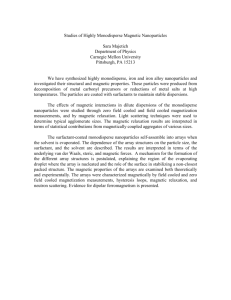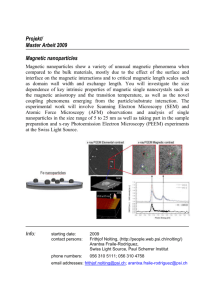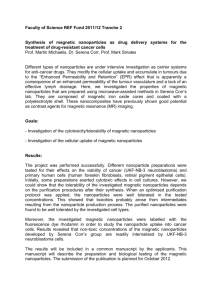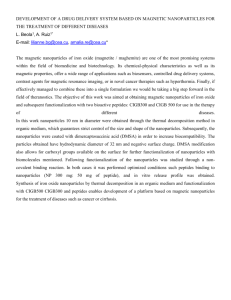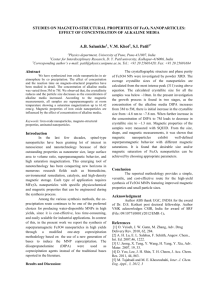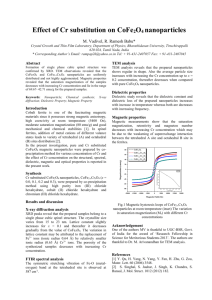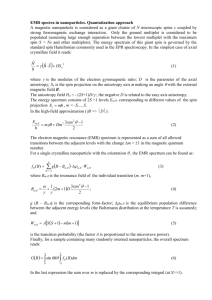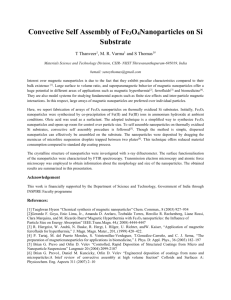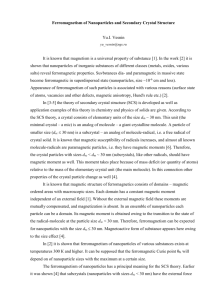View
advertisement
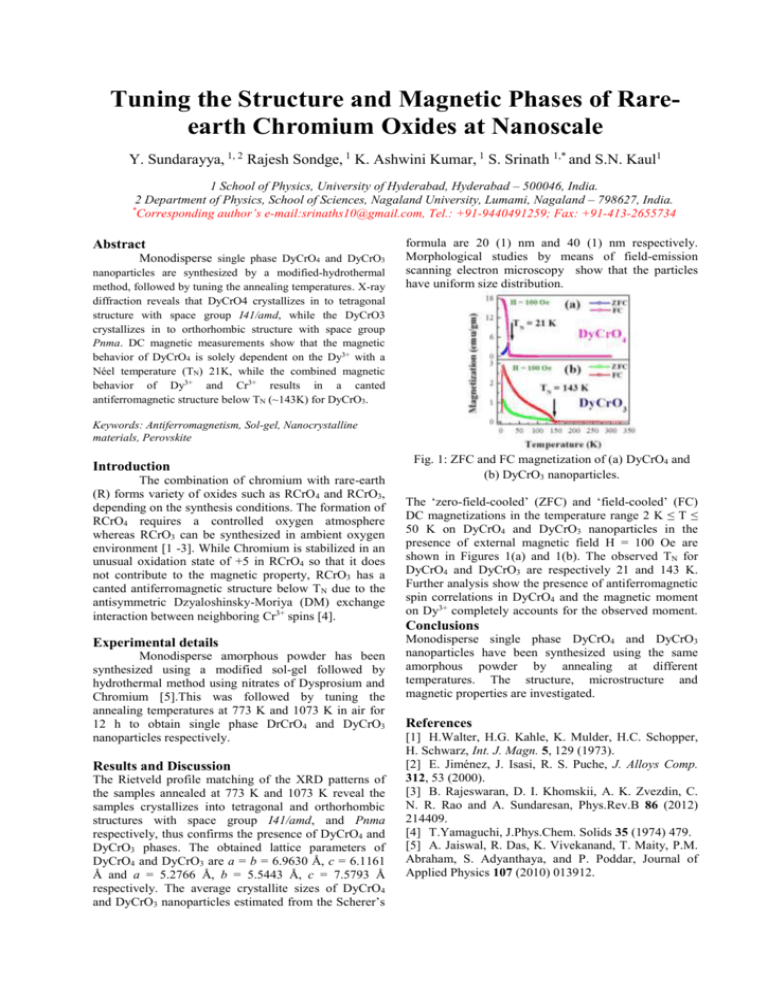
Tuning the Structure and Magnetic Phases of Rareearth Chromium Oxides at Nanoscale Y. Sundarayya, 1, 2 Rajesh Sondge, 1 K. Ashwini Kumar, 1 S. Srinath 1,* and S.N. Kaul1 1 School of Physics, University of Hyderabad, Hyderabad – 500046, India. 2 Department of Physics, School of Sciences, Nagaland University, Lumami, Nagaland – 798627, India. * Corresponding author’s e-mail:srinaths10@gmail.com, Tel.: +91-9440491259; Fax: +91-413-2655734 Abstract Monodisperse single phase DyCrO4 and DyCrO3 nanoparticles are synthesized by a modified-hydrothermal method, followed by tuning the annealing temperatures. X-ray diffraction reveals that DyCrO4 crystallizes in to tetragonal structure with space group I41/amd, while the DyCrO3 crystallizes in to orthorhombic structure with space group Pnma. DC magnetic measurements show that the magnetic behavior of DyCrO4 is solely dependent on the Dy3+ with a Néel temperature (TN) 21K, while the combined magnetic behavior of Dy3+ and Cr3+ results in a canted antiferromagnetic structure below TN (~143K) for DyCrO3. formula are 20 (1) nm and 40 (1) nm respectively. Morphological studies by means of field-emission scanning electron microscopy show that the particles have uniform size distribution. Keywords: Antiferromagnetism, Sol-gel, Nanocrystalline materials, Perovskite Introduction The combination of chromium with rare-earth (R) forms variety of oxides such as RCrO 4 and RCrO3, depending on the synthesis conditions. The formation of RCrO4 requires a controlled oxygen atmosphere whereas RCrO3 can be synthesized in ambient oxygen environment [1 -3]. While Chromium is stabilized in an unusual oxidation state of +5 in RCrO4 so that it does not contribute to the magnetic property, RCrO3 has a canted antiferromagnetic structure below T N due to the antisymmetric Dzyaloshinsky-Moriya (DM) exchange interaction between neighboring Cr3+ spins [4]. Experimental details Monodisperse amorphous powder has been synthesized using a modified sol-gel followed by hydrothermal method using nitrates of Dysprosium and Chromium [5].This was followed by tuning the annealing temperatures at 773 K and 1073 K in air for 12 h to obtain single phase DrCrO4 and DyCrO3 nanoparticles respectively. Results and Discussion The Rietveld profile matching of the XRD patterns of the samples annealed at 773 K and 1073 K reveal the samples crystallizes into tetragonal and orthorhombic structures with space group I41/amd, and Pnma respectively, thus confirms the presence of DyCrO4 and DyCrO3 phases. The obtained lattice parameters of DyCrO4 and DyCrO3 are a = b = 6.9630 Å, c = 6.1161 Å and a = 5.2766 Å, b = 5.5443 Å, c = 7.5793 Å respectively. The average crystallite sizes of DyCrO4 and DyCrO3 nanoparticles estimated from the Scherer’s Fig. 1: ZFC and FC magnetization of (a) DyCrO4 and (b) DyCrO3 nanoparticles. The ‘zero-field-cooled’ (ZFC) and ‘field-cooled’ (FC) DC magnetizations in the temperature range 2 K ≤ T ≤ 50 K on DyCrO4 and DyCrO3 nanoparticles in the presence of external magnetic field H = 100 Oe are shown in Figures 1(a) and 1(b). The observed TN for DyCrO4 and DyCrO3 are respectively 21 and 143 K. Further analysis show the presence of antiferromagnetic spin correlations in DyCrO4 and the magnetic moment on Dy3+ completely accounts for the observed moment. Conclusions Monodisperse single phase DyCrO4 and DyCrO3 nanoparticles have been synthesized using the same amorphous powder by annealing at different temperatures. The structure, microstructure and magnetic properties are investigated. References [1] H.Walter, H.G. Kahle, K. Mulder, H.C. Schopper, H. Schwarz, Int. J. Magn. 5, 129 (1973). [2] E. Jiménez, J. Isasi, R. S. Puche, J. Alloys Comp. 312, 53 (2000). [3] B. Rajeswaran, D. I. Khomskii, A. K. Zvezdin, C. N. R. Rao and A. Sundaresan, Phys.Rev.B 86 (2012) 214409. [4] T.Yamaguchi, J.Phys.Chem. Solids 35 (1974) 479. [5] A. Jaiswal, R. Das, K. Vivekanand, T. Maity, P.M. Abraham, S. Adyanthaya, and P. Poddar, Journal of Applied Physics 107 (2010) 013912.
